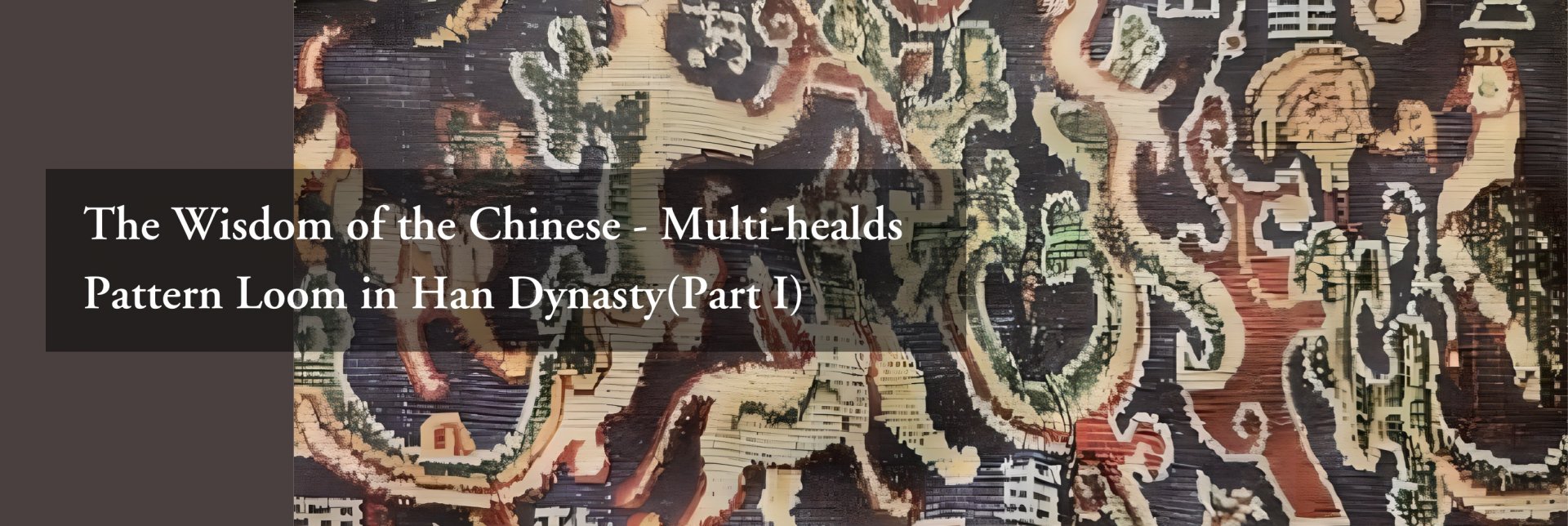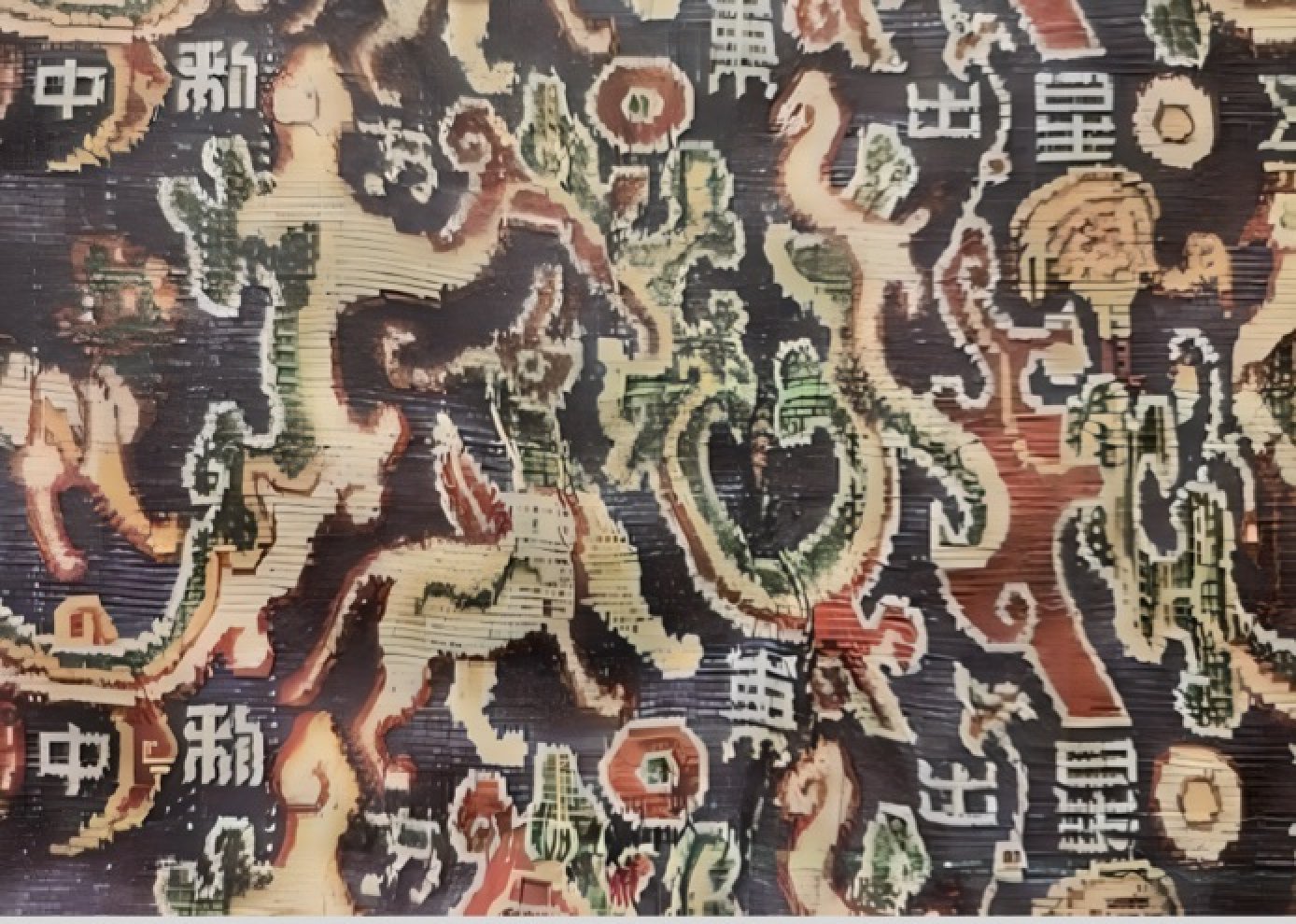The Wisdom of the Chinese - Multi-healds Pattern Loom in Han Dynasty(Part I)
Silk kingdom since ancient times
China has been known as the kingdom of silk since ancient times. Silk has won the recognition of the world for its excellent quality. In the previously excavated Shang Dynasty oracle bones, divinations regarding silkworms, mulberry trees, and silk production were already recorded. By the Zhou Dynasty, the silk industry had developed very quickly with the people learning to plant shorter mulberry trees in which the silk farming methods became mature. The "Article on Silkworms"(蠶賦) written by Xunzi (荀子) described the dichotomy of male and female silkworms. At that time, the Zhou people already knew how to use boiling water to soak cocoons and spin silk, and the hand-operated spinning tools had appeared. Many brocades were found in unearthed relics, but there were often errors in the outlook of the patterns, which demonstrated that the pattern loom weaving technology was not yet mature.
During the Warring States period, there were frequent exchanges between the lords, economic activities enhanced and thus the productivity increased. Silk began to gradually spread among the civilians, and there was a saying that "if a woman does not weave, she will be cold." In the early Han Dynasty, agriculture and sericulture were given priority, and with the light tax burden, the economy quickly recovered. The royal family valued sericulture and textile production, establishing the "Three-robe Officials" (三服官). During the reign of Emperor Wu of Han(漢武帝), Zhang Qian (張騫)went on a mission to the Western Regions and opened up the Silk Road, enhancing the production, technological exchange, and improvement of the silk industry. The silk textile industry grew rapidly. As the old saying tells that "A foot of silk is a thousand taels of gold, and the weaving is full of ingenuity.". It is characterized by luster and softness, delicate to skin, high drapeability and comfortability, and is highly praised by people all over the world. How was silk woven in ancient times? In particular, how was brocade rich in design made? This has always been a mystery of archeology.
Mystery still unsolved
In 1995, a national treasure-level relic was discovered in Hetian, Xinjiang- a woven silk piece called "Five Stars Rise in the East to Benefit China." This silk textile had extremely high precision in its yarn filament, pattern complexity, and color brilliance. The unique aspect was the clear Chinese characters "Five Stars Rise in the East to Benefit China," which were woven using a pattern loom during the Han Dynasty. This piece of woven silk was one of the most difficult to produce because of its high warp density and high degree of difficulty in pattern formation. This woven silk displayed in five colors- blue, green, white, red, and yellow, among which the most complex and interesting was this row of Chinese characters "Five Stars Rise in the East to Benefit China," which conformed to the description in "Records of the Grand Historian" (史記)that is “five stars gather in the east, and China benefit.” This story was about how the five stars gathered in the east, China greatly benefited, the southern territories were pacified, the barbarians surrendered, and there was peace with heaven. In fact, the appearance of this piece of silk is extremely precious. The museum had tried to restore it with the textile technology of Song and Ming Dynasties. Anyway, how exactly did the Han Dynasty weave this complex and interesting tapestry for archaeologists?

A wonderful coincidence
In October 2012, during the construction of the Chengdu metro, the Lao Gunshan Han tomb complex was discovered. In Tomb 2, four loom models and fifteen wooden figurines were unearthed, displaying the production workshop of the brocade during the Western Han Dynasty. Its revealed Shu Han brocade production was mainly dependent on males. The four male weavers in the tomb were sitting on looms to work, while the eleven female wooden figurines represented the preparatory work.

By studying the Han Dynasty textile machine, one can have a better understanding of the development process of Han Dynasty textiles and the important role of pattern loom technology in silk production. The entire archaeological discovery is profoundly significant for resolving the technical problems in weaving and especially for understanding the production of Han brocade along the Silk Road.This discovery is a perfect combination of hardware and software. Only in this way, it can have such a brilliant Han brocade being produced.
Time Shift- Han’s Textile technology
In October 2015, the China Silk Museum and the Chengdu Museum jointly released the research findings on the restoration of the Han Dynasty pattern loom, which received wide attention. The technological restoration of the loom model would be very amazing!
In order to restore the national treasure Han brocade, the research team spent three years restoring the loom unearthed from the Laoguanshan Han Tomb and then developed a restoration plan for the Han brocades unearthed in Xinjiang. During the restoration process, they focused on the elements of the brocade such as its color, warp density and composition and construction, to determine the weaving process and the scheme. At the same time, the research team also went to Xinjiang to carry out detailed scientific analysis and tests, laying a good foundation for scientific restoration. In before, even with the weaving technology of the Song and Ming dynasties, only a short section could be woven on a 50 cm width loom. The outcome hand feel was very stiff, far from the softness of the original. Having appeared rigid and stiff, it impossible to create a complete piece of fabric. However, through careful research and analysis, this restoration project utilized the "original machinery, original craftsmanship, and original technology" method to recreate the authentic Han dynasty pattern loom techniques and artistry. This approach is more feasible than other replication methods and results.
Computer programming as far back as Han Dynasty
Experts confirmed through in-depth research that these looms belong to the multi-healds hooked type, which was the pinnacle of Han Dynasty textile technology. The loom weaves the warp and weft yarns in mechanical way to form the shed, in which the warp yarns composed of two layers, one layer lifts up, and the other layer presses down, allowing the weft yarn to pass through to form the fabric. In order to make complicated designs, the pattern loom needs to accurately lift the corresponding warp yarns according to the rules, and then weave in the corresponding weft yarns. Depending on the design of the fabric, the structure of the shedding is sometimes a ratio of one upper warp yarns to four lower warp yarns or a ratio of one to five. This requires the loom to have certain smart mechanical functions to complete this complex operation. When dealing with intricate designs, the shedding process can be very complicated and challenging to execute. It is also extremely difficult to remember the complex shedding information. Multiple devices therefore are installed to store this information, allowing for the recycling of the shedding memory. This is analogous to modern computer programming. The operations can be repeated without the need to restart each time. This technique is undoubtedly one of the most challenging aspects of brocade weaving. The design is stored on the releasable device, the multiple heald frames, which are the main components for forming patterns of the fabric. The weaver control the selection of the heald through sliders picking the desired frame by hooks, in which is of a complex structure and wisdom function. Thus, it can produce high-quality brocade.

主要參考文獻
1、Feng Zhao,Yi Wang,Qun Luo,Bo Long,Baichun Zhang,Yingchong Xia,Tao Xie,Shunqing Wu & Lin Xiao(2017). The Earliest Evidence Of Pattern Looms:Han Dynasty tomb models from Chengdu,China. Published online by Cambridge University Press
2、黃能馥,陳娟娟 著:《中國絲綢科技藝術七千年-歷代織綉珍品研究》, 北京:中國紡織出版社,2002年版。
3、王樂編著,趙豐總主編:《中國古代絲綢設計素材圖系-漢唐卷》,杭州:浙江大學出版社,2016年版。
4、龍博:<成都老官山漢墓出土提花織機的復原研究>, 中國絲綢博物館 《國絲課堂》Vol.16,2020-12-28
5、龍博:<“五星出東方利中國”漢錦的複製>,中國絲綢博物館, 《國絲課堂》Vol.21, 2021-05-07。
6、趙豐、周暘、劉劍 等著:《中國紡織考古與科學研究》,上海:上海科學技術出版社,2018年版。
7、韋黎明、李小瓊編著:《中國的絲綢》,香港:和平圖書有限公司,2003年版。
8、趙豐、徐錚著:《錦綉華服·古代絲網染織術》,北京:文物出版社,2008年版。
9、趙翰生著:《中國古代紡織與印染》,北京:中國國際廣播出版社,1996年版。
All articles/videos are prohibited from reproducing without the permission of the copyright holder.




Welcome to leave a message:
Please Sign In/Sign Up as a member and leave a message